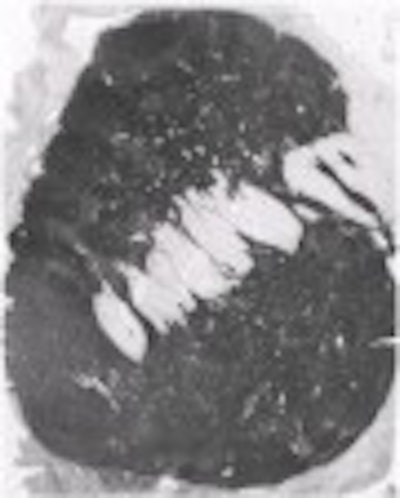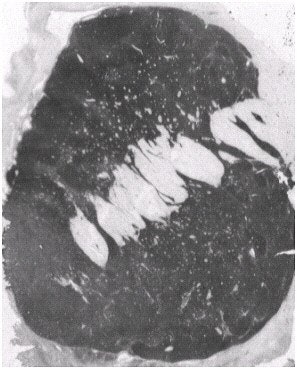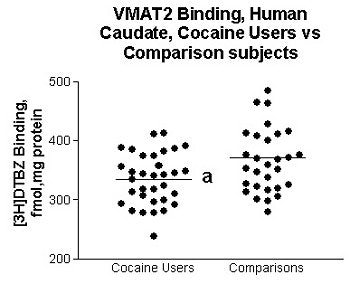
University of Michigan investigators have found that chronic cocaine users lose vesicularmonoamine transporter protein (VMAT2), which could indicate damage to striatal dopamine fibers. These neuronal changes might also play a role in causing mood and motivational disorders commonly seen in severely cocaine-dependent patients, they reported in American Journal of Psychiatry.
"For a long time we have known that cocaine causes a pleasurable response immediately after it’s taken because it increases dopamine levels in the brain," said lead author Dr. Karley Little in an interview with AuntMinnie.com. "This is the clearest evidence to date that the specific neurons cocaine interacts with don't like it and are disturbed by the drug's effects. The questions we now face are: Are the cells dormant or damaged? Is the effect reversible or permanent, and is it preventable?"
Little is an associate professor of psychiatry at the University of Michigan School of Medicine and chief of the VA Healthcare Systems Affective Neuropharmacology Laboratory, both in Ann Arbor. This is the latest research from Little and his team, who began comparing brain tissue samples from cocaine abusers and control subjects in 1993.
When a pleasurable event happens, dopamine neurons pump the chemical into the gaps between themselves and related brain cells. Dopamine travels to receptors on neighboring cells, triggering signals that activate pathways to different feelings or sensations.
Normally, dopamine returns to its home cell, entering through a transporter. VMAT2 acts as a pump to pull returning dopamine into vesicles. Cocaine blocks the transporters that return dopamine to its home cell. This causes dopamine to accumulate in the synapse, where it binds with other cells' receptors and sends pleasure signals repeatedly. This helps cause the intense "high" that cocaine users feel.
Little and his team had previously shown that cocaine users have higher numbers of dopamine transporters, suggesting that the cells have tried to make more return gateways to compensate for blocked ones. In chronic users, the use of cocaine for pleasure evolves into its use to avoid negative feelings associated with the absence of cocaine (American Journal of Psychiatry, February 1999, Vol.156:2, pp. 238-245).
The new research illustrates the molecular mechanisms involved as dopamine-producing brain cells try to adapt to a cocaine-drenched environment.
The group used molecular measures to assess changes in dopamine neuronal health. They looked at levels of VMAT2, as well as VMAT2's binding to a selective radiotracer molecule -- dihydrotetrabenazine ([3H] DTBZ) -- and overall dopamine levels. Levels of the molecule in chronic cocaine users were significantly lower than those of control subjects; levels tended to be lowest in cocaine users with depression.
 |
| Autoradiograph of [3H]DTBZ binding to human striatum. Image courtesy of Dr. Karley Little. |
The group examined brain samples removed during autopsy from 35 known cocaine abusers and 35 non-drug users with similar profiles of age, sex, race, and causes of death.
"The hypothesis that human cocaine users lose vesicular monoamine transporter (VMAT2) protein was tested in striatal samples from cocaine users and age-, sex-, and postmortem interval-matched comparison subjects," Little reported. "Striatal samples were retrieved at autopsy; immunoblot assays were then performed by using a highly specific VMAT2 antibody. Striatal radioligand binding to VMAT2 was assessed with dihydrotetrabenazine ([3H]DTBZ), and dopamine levels employing high-performance liquid chromatography" (American Journal of Psychiatry, January 2003, Vol.160:1, pp.47-55).
Little described the imaging protocol for this study as follows: "The autoradiographic assay methods for (+)-[3 H]DTBZ were16-micron-thick sections that were incubated at 2° C in Tris buffer (50 mM, 120 mM NaCl, pH 7.4) for 1.5 hours. An initial saturation study indicated a dissociation constant (Kd) of 1.9 nM (SD=0.1) in human striatum. On the basis of this result, a single saturating concentration of [3H]DTBZ (10 nM) was used to assess binding in the striatum, by means of two total and one nonspecific sections. Nonspecific binding was defined with reserpine, 10 mM," he said.
"After incubation, the slides were washed and then apposed to Kodak SB-5 film for 5-7 days. Amersham Bioscience tritium microscale standards were co-exposed for each cassette. Optical densities were determined by using an image analysis system (Microcomputer Imaging Devices, Ottawa, Ontario, Canada). Optical densities were evaluated by comparison to the Amersham standards and are expressed in nanocuries per milligram." The results are illustrated in the graph below.
 |
"Cocaine users displayed a marked reduction in VMAT2 immunoreactivity, as well as reduced [3H]DTBZ binding and dopamine levels," Little said. "It did not appear that the reduction in VMAT2 immunoreactivity was related to ethanol use, but dopamine levels were lower in subjects with only ethanol diagnoses. Subjects suffering from cocaine-induced mood disorders displayed a greater loss of VMAT2 immunoreactivity that approached significance."
Cindy Miner, Ph.D., chief of science policy at the National Institute of Drug Abuse in Washington, DC, called the research a "pioneering study. It raises the possibility that cocaine use causes damage to the brain, which is an unexpected result following prior animal studies that seemed to suggest otherwise. It isn't possible to say yet whether the cellular damage observed by these researchers is temporary or permanent, but at the very least it is a 'first' and intriguing finding that sets a direction for further research."
The next step for Little’s team will be to count the dopamine neurons and axons in the samples to see if any increase or decrease takes place.
"If we find they are not decreased then it will mean we are dealing with a down-regulation process, a reduction in dopamine in response to cocaine use," Little explained. "If the numbers are diminished then we are dealing with unprecedented neuronal loss. If the change is permanent it’s a serious problem, and if it is reversible then we must find out the mechanism by which it can be reversed."
By Bruce SylvesterAuntMinnie.com contributing writer
January 20, 2003
Related Reading
MRI study finds that Ecstasy use may lead to axonal brain injury, September 18, 2001
Copyright © 2003 AuntMinnie.com




















